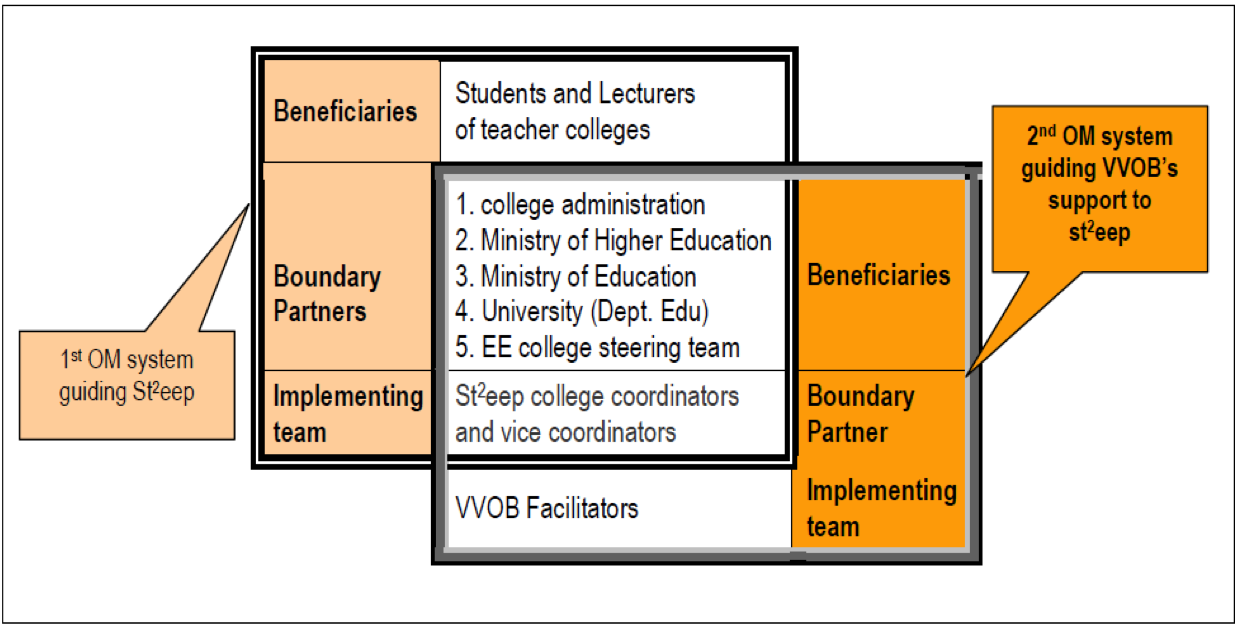Outcome Mapping Practitioner Guide
Working with nested OM frameworks
This nugget describes how nested or integrated OM systems can provide an effective strategy towards ensuring programme sustainability and provide a framework for planning an exit strategy for an external funding organisation.
Author: Jan Van Ongevalle
Published: Sunday 21 September 2014
VVOB, a Belgian semi-governmental development organisation, supported the integration of environmental education (EE) in the secondary teacher training curriculum in Zimbabwe through the St2eep project (2003-2008). The project was initially planned using the logical framework approach. Due to a growing concern about future sustainability of the project’s results, a reformulation of the project was organised in 2005 using outcome mapping. The workshop initiated a dialogue between St2eep, the Ministry of Higher Education and the College administrators on the incorporation of St2eep into the existing college structures and the development of a phased exit strategy for the external donor organisation, VVOB. This resulted in the design of two ‘nested’ or interconnected OM systems (see figure below):
- OM system 1: The St2eep coordinating team, a newly established local structure within the colleges, as project implementing team that was set up to influence or support the college EE steering teams, college administrations, respective ministry departments and the University of Zimbabwe (i.e. the boundary partners to the St2eep coordinating team) in their work around environmental education; and
- OM system 2: VVOB (or other future supporting/funding agencies) as project implementing team that was influencing and supporting the St2eep coordinating team (i.e. the boundary partner to VVOB).

The nested OM frameworks provided a plan for the gradual ‘exit’ of the VVOB facilitators (expatriate Belgian staff). Since VVOB had committed itself to further support St2eep from 2006 until the end of 2008, the role of VVOB (and potentially other donors) in supporting St2eep was clarified during the OM workshop. OM therefore provided a framework for St2eep and VVOB to facilitate a change in their role in educational development programs from program coordination to facilitation of capacity development processes. By developing a nested or interconnected OM system with the St2eep coordinating teams becoming the boundary partners of VVOB, VVOB could focus its support on influencing change in the behaviour and actions of the St2eep EE coordinating teams. This way the St2eep EE coordinating teams on their part were then capacitated to support their boundary partners (i.e. local actors) who play an active part in the integration and implemantation of EE in the colleges and who will continue to do so even after the departure of VVOB.
In this nested OM system, the progress markers of the St2eep EE coordinating teams who were supported by VVOB, are also the support strategies implemented by the St2eep EE coordinating teams towards their boundary partners (i.e. college administration, EE steering teams, etc…).
This nugget was applied in: This nugget describes how nested or integrated OM systems can provide an effective strategy towards ensuring programme sustainability and provide a framework for planning an exit strategy for an external funding organisation.
Related Practitioner Guide sections:



